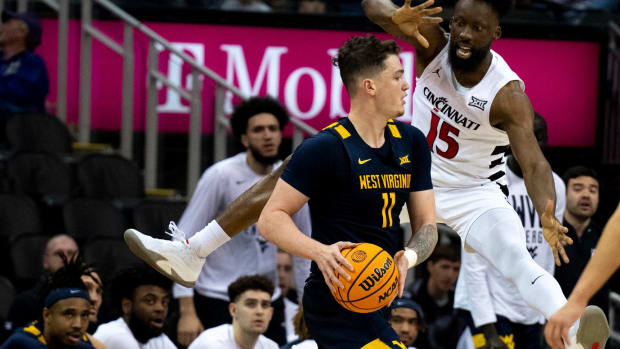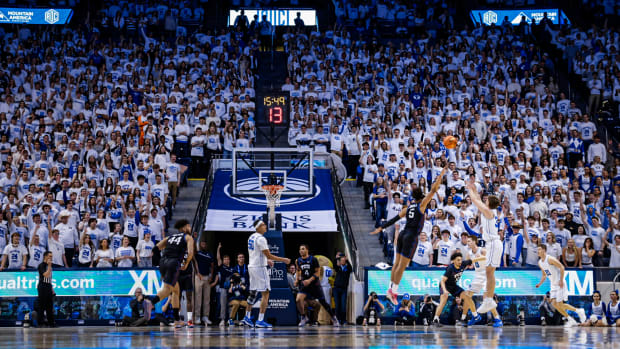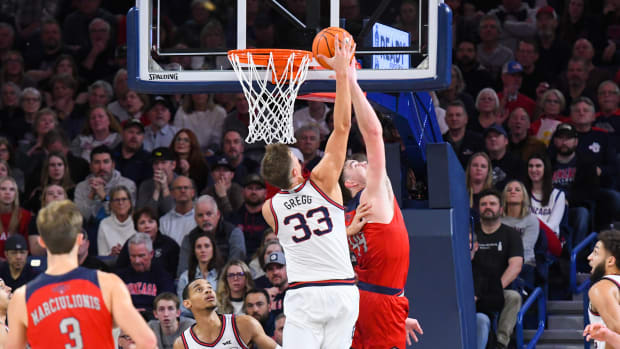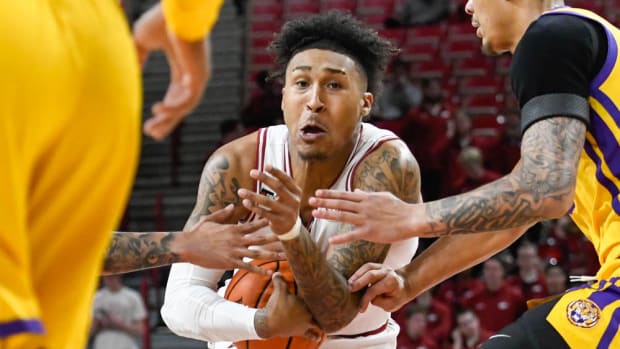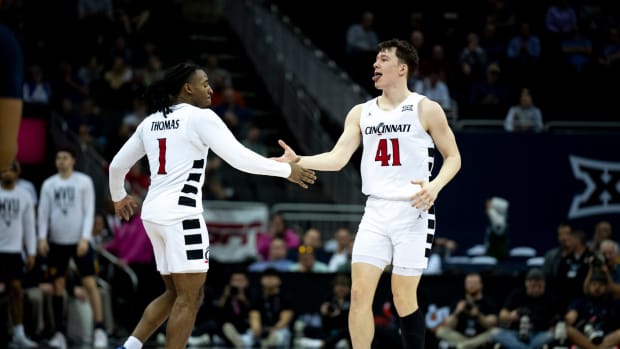College Basketball Coaches, Recruits Left in a Tough Spot Amid Shutdown
Two years ago at this time, the college basketball programs interested in Christian Braun of Overland Park, Kansas, were primarily mid-majors. He was an under-the-radar shooting guard on a loaded Mokan Elite AAU team.
By mid-July, that had changed. Braun lit up the Peach Jam tournament in Augusta, shot into the Top 100 prospects in the Class of 2019 and started hearing from the big boys. By November 2018 he was signing with the Kansas Jayhawks, and this past season he was an impact contributor on the nation’s No. 1 team as a freshman.
Three years ago at this time, Jericole Hellems was in pretty much the same position. The 6-foot-7 wing from St. Louis was a role player for Brad Beal Elite, arriving at Peach Jam with three scholarship offers. After a big week, he left with 24 offers and wound up signing with North Carolina State, where he has been a key contributor for two seasons.
MORE: Inside the Pandemic's Impact on College Football Recruiting
National tournaments in the spring and summer, like the ones that raised the profiles of Braun and Hellems, are often where the action is in recruiting.
“This is when people emerge,” said Chris Neff, coach of Mokan Elite and also at Staley High School in Kansas City. “This is when rankings change. You get the cream of the crop together and sort out who’s going to get these offers.”
Neff paused.
“Now, that ain’t happening.”
Now, nothing is happening in basketball recruiting, at least in terms of live competition and evaluation. The COVID-19 pandemic has shut it all down. Nike and Under Armour had big events scheduled for this weekend and the following one, but those have been canceled. The outlook for the big July tourneys ranges from uncertain to pessimistic.
The locked gym doors could be keeping the next Christian Braun or next Jericole Hellems—rising stars in the classes of 2021 and ’22—from breaking out.
Neff and Brad Beal Elite coach Corey Frazier have current players who, in a normal world, would be playing right now to raise their profile. Neff has a Class of 2021 guard named Stevie Strong who he swears is a high mid-major talent, at least, but at 5' 9" and playing at a mid-sized school, he hasn’t gotten offers yet. Frazier has a four-star 2021 player named Jordan Nesbitt whose stock dropped last summer but was on the rise over the winter—and now he is missing an opportunity to improve his rivals.com No. 82 national ranking.
“For us,” said Brad Beal Elite coach Corey Frazier, “it’s a difficult time.”
It’s a difficult time for college recruiters, too. They may look dazed and bored at times after hours on the bleachers watching helter-skelter AAU ball, but you often don’t miss something until it’s gone. Coaches realize the importance of in-person evaluation, and the details they might be missing without it.
“I’ll miss the evaluation time,” said Georgia coach Tom Crean. “The things you can’t see as well on film—how do they respond to coaching, what is their body language, what are they doing when they don’t think anybody is looking? You can’t see the mannerisms, can’t see the eye rolls, can’t see the lack of eye contact.”
Without that in-person knowledge, coaches are relying on game video like never before. Fortunately, there is more of it available than ever before.
Both Neff and Frazier have asked their players to submit all their tape from HUDL, a popular video service. They’re combining that with their own game tapes to create accessible video libraries for all their prospects, including situational cut-ups and advanced stats. (“Fortunately, everyone has Synergy now,” said Neff, referring to the basketball-centric analytics company.) They’re also writing personal reports on their players and distributing them to college coaches.
“We are reaching out to coaches,” Frazier said. “Right now, it’s effective—it forces coaches to listen. They don’t want to miss on kids right now, so they have to watch the film and they have to listen to what we’re telling them.”
Crean called the current situation an “evaluation and investigation phase, because you’re not getting anything face-to-face.” He said he’s spending the majority of his work time watching film, then making calls with coaches and others tied to prospects while riding his bike or going on walks.
In terms of communicating with the prospects themselves, it’s going to be a FaceTime, text and Zoom call world for the foreseeable future. SI All-American writer Jason Jordan said he believes the time is coming when players with access to a gym will FaceTime individual workouts for recruiters.
That’s not quite the same as being in the gym.
Nor, for prospects, are virtual campus tours the same thing as being there. Campus visits, whether official or unofficial, are vital elements on both sides of the equation.
Louisville coach Chris Mack is chagrined that a big Adidas event that was going to be in town this month has been canceled. In normal circumstances that would be an ideal vehicle for getting prospects on campus to see facilities and living space, and to further build relationships.
“We’re watching more film that ever and we’re on the phone like mad men,” Mack said.
But phone calls aren’t the same as home visits, either.
Eventually, coaches likely will be faced with embracing something they’re reluctant to do—offering scholarships to prospects sight unseen.
“Gracious sakes, I hate to make a decision based on tape and without putting my eyes on someone personally,” North Carolina coach Roy Williams said.
“You have to,” Crean said. “I don’t think there’s any way around it right now. You hope you can come across seeing them live at this point, but nobody knows when that will be.”
Sometimes those blind gambles can work out well. Davidson coach Bob McKillop checked into a shooter from Regis High School in New York—the same school where Dr. Anthony Fauci was the basketball team captain—named Peter Anderer late in the 1999 recruiting cycle. Anderer was not recruited and heading to Columbia as a regular student, but one of McKillop’s assistants had seen him play volleyball and was impressed by his athleticism—which, coupled with his shooting ability, made him a recruitable player.
McKillop offered him a walk-on spot, with the chance to earn a scholarship after his freshman year. When Anderer finished playing in 2002, he was Davidson’s career leader in three-pointers made.
Those are good stories, but also rare stories. Both the coaches and the prospects know their chances of making these important life decisions work out well are enhanced by home visits and campus visits, and by being seen in the gym. It’s hard to FaceTime your way to a fully informed decision. And it's hard for an underrated player to blow up without playing games.
But for now, options are limited. And nobody knows when that will change.
“I hope it’s just the now normal and not the new normal,” Neff said. “Because it ain’t a lot of fun.”
More From SI.com Sites:
Players That Will Be at the Center of 2021 Recruiting Battles
2020 Hoops Class Another Sign of Changing Culture at Alabama
SI's Top 10 2020 Basketball Recruiting Class Rankings

